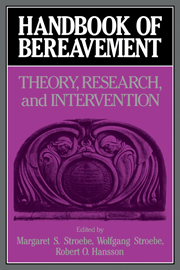Book contents
- Frontmatter
- Contents
- Contributors
- Preface
- Part I Introduction
- Part II The phenomenology and measurement of grief
- Part III Current theories of grief, mourning, and bereavement
- Part IV Physiological changes following bereavement
- Part V The psychological, social, and health impacts of conjugal bereavement
- Part VI Grief reactions to different types of loss
- Part VII Coping, counseling, and therapy
- 23 The meaning of loss and adjustment to bereavement
- 24 Old age and widowhood: Issues of personal control and independence
- 25 The support systems of American urban widows
- 26 The role of social support in bereavement
- 27 Bereavement self-help groups: A review of conceptual and methodological issues
- 28 Counseling and therapy of the bereaved
- Part VIII Conclusions
- References
- Author index
- Subject Index
24 - Old age and widowhood: Issues of personal control and independence
Published online by Cambridge University Press: 04 May 2010
- Frontmatter
- Contents
- Contributors
- Preface
- Part I Introduction
- Part II The phenomenology and measurement of grief
- Part III Current theories of grief, mourning, and bereavement
- Part IV Physiological changes following bereavement
- Part V The psychological, social, and health impacts of conjugal bereavement
- Part VI Grief reactions to different types of loss
- Part VII Coping, counseling, and therapy
- 23 The meaning of loss and adjustment to bereavement
- 24 Old age and widowhood: Issues of personal control and independence
- 25 The support systems of American urban widows
- 26 The role of social support in bereavement
- 27 Bereavement self-help groups: A review of conceptual and methodological issues
- 28 Counseling and therapy of the bereaved
- Part VIII Conclusions
- References
- Author index
- Subject Index
Summary
Research on bereavement and widowhood typically has focused on understanding the nature of the phenomenon, short-term consequences, and processes underlying recovery. Few investigations have attended systematically to the contexts in which widowhood is experienced or to the likely influence of age-related changes in a widow's coping resources. Yet a number of such themes broadly influence the experience of widowhood in Western society.
First, widowhood usually occurs in one's later years; in the United States the mean age at widowhood is 69 years for men and 66 years for women. Second, it is primarily a women's issue, because of sex differences in expected life span favoring females and because men tend to marry women younger than themselves and are more likely to remarry following the death of a spouse. Among people 65 years or over, 51% of women compared to 13% of men are widowed (U.S. Bureau of the Census, 1984). On this point, however, it is noteworthy that widowers, although a minority, also experience serious adjustment problems, and much of the discussion to follow applies also to them (M. Stroebe & Stroebe, 1983). A third concern is that widowed individuals are more likely to live alone and on a reduced income. Finally, and perhaps most important for the purposes of this chapter, widowed persons, especially women, have much of their life still before them. The mean duration of widowed life is approximately 14 years for women and 7 years for men (U.S. Bureau of the Census, 1984).
- Type
- Chapter
- Information
- Handbook of BereavementTheory, Research, and Intervention, pp. 367 - 380Publisher: Cambridge University PressPrint publication year: 1993
- 7
- Cited by



